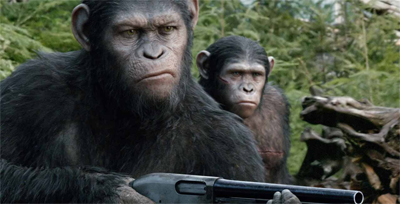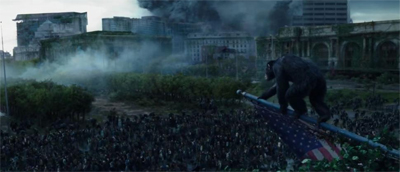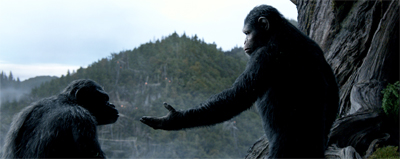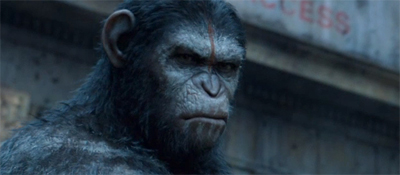Constructing a satisfying sequel is an artform unto itself. It is something that requires a great deal of skill. As with any aspect of filmmaking, building off an earlier film is a very difficult thing to do. Producing a sequel comes with its own set of artistic risks and challenges, its own obstacles and hurdles. Navigating those potential problems and finding a way to meet (and even surpass) expectations without straying too far from the framework of the original film is difficult.
As with making any movie, there are existing frameworks and structures that do a little help make navigating those problems a little easier. Perhaps the structure of Star Wars: The Empire Strikes Back is the most obvious example. Using the trust established by the first film, the ensemble are split up to carry different strands of the plot, revealing scattered pieces of a larger whole, before reuniting for an epic finalé. Bryan Singer used this approach for X-Men II and How to Train Your Dragon 2 also followed it.
Dawn of the Planet of the Apes is in an interesting position. It is a sequel to a remake; a remake of a film franchise that was originally iconic and influential, before dying a slow and humiliating public death as the series diminished and collapsed. Not only does Dawn of the Planet of the Apes come with the expectations of Rise of the Planet of the Apes, it comes with the revived expectations of the entire Planet of the Apes franchise; expectations restored by Rise of the Planet of the Apes.
Dawn of the Planet of the Apes chooses a very clever structure for this sequel, loosely following the sequel framework typified by Christopher Nolan’s work on The Dark Knight. This is a very clever approach, and it pays dividends. Dawn of the Planet of the Apes is an ambitious and exciting sequel, a wonderful post-apocalyptic epic and an engaging moral parable.
Structure is fascinating. It can become a hindrance if it becomes a formula, if it is followed without passion or energy. It can become a easy way of telling a particular story, a reductive and simplistic method of generating narrative. The phrase “Die Hard on a…” hardly instils confidence, any more than “the same as last time, but with a bigger budget!” There are certain movie-making formulas and patterns that become stock and cliché and rote.
That said, structure is like any other tool – it can be used wisely cleverly, or lazily and generically. Dawn of the Planet of the Apes is very shrewd in how it structures its sequel. Rise of the Planet of the Apes had the luxury of arriving without any expectations. The most generous account of Tim Burton’s Planet of the Apes is that it was an interesting and ambitious experiment. Even before that, the Planet of the Apes franchise had entered a cycle of diminishing returns.

“Could this be the start of a terrifying Planet of the Horses? In this announcer’s opinion, almost certainly yes!”
When Charleton Heston blew up the eponymous planet at the climax of Beneath the Planet of the Apes, the franchise only managed to limp on a few films longer. However, the unlikely breakout blockbuster of 2011, Rise of the Planet of the Apes demonstrated the series had some life in it yet. One of the better-received blockbusters of the year, the reboot set expectations quite high for the inevitable sequel.
As such, it’s no surprise that Dawn of the Planet of the Apes should adopt the sequel model typified by Christopher Nolan’s The Dark Knight. Much like Rise of the Planet of the Apes, Batman Begins had demonstrated that there was life in what looked to be a dead franchise. Nolan built on that basic premise for the sequel, producing an ambitious and audacious blockbuster that used the original film as a springboard to something altogether more epic and philosophical.
As with The Dark Knight, Dawn of the Planet of the Apes begins by extrapolating – rather than simply following on – from the ending to the last film. Unnecessary cast members are jettisoned. The world of the film is de-cluttered, bother literally and narratively. The first half of the film is structured in a way that would make it the climax of any other feature. There is a clear objective and goal, one that seems impossible, only for our heroes to somehow manage to accomplish it.
This structure is rather odd. It builds towards what seems like a logical (and seemingly inevitable) conclusion for a film like this. However, it doesn’t place this climax in the third act, as people might expect. Instead, the film blows everything up in the middle of its runtime, allowing for drama and excitement as the cast scramble to pick up the pieces. It’s a very clever structure, because it moves what should be the end of the film to around the half-way or two-third-way point, making the movie feel “bigger.”
In The Dark Knight, the initial set-up suggests that Bruce Wayne wants to defeat the Joker and allow Harvey Dent to take his place in Gotham. This seems quite unlikely to occur, given the Joker’s reign of terror – even managing to “kill” Jim Gordon. Then, suddenly, Batman manages to capture the Joker during an attack on Harvey Dent. There’s a chase. Gordon is alive. The day is saved. Except it’s not.
The Dark Knight builds to an inevitable and foreseen climax (if Harvey Dent is a major character in a Batman movie, it will likely be an origin for Two-Face), something that seems like it should be a climactic cliffhanger ending in the style of The Empire Strikes Back. However, once it has reached that point, it just pushes past it and follows it to a point that marks a logical end for most of the characters involved in the narrative.
Dawn of the Planet of the Apes follows a similar structure. The movie follows attempts to build a meaningful friendship between a dying humanity and an ascendant ape population, centred around attempts to restore power to a small community of survivors living in San Francisco. Again, the narrative pushes against something the audience knows to be an inevitability. Given the film title includes the words “Planet of the Apes” and everybody knows the outcome, this cannot end well for the humans.
However, the movie shrewdly moves what might otherwise by the climax into the middle of the film. It catches the audience off-guard, and throws everything up into the air. It’s a delightfully ambitious decision, and the fact that plays so skilfully on audience expectations – by delivering an expected development at an unexpected time. Dawn of the Planet of the Apes runs just over two hours, but it feels like it packs a lot into that runtime.
Again, structure is only a tool. This framework is effective and shrewd, but it only provides a foundation for director Matt Reeves and writers Mark Bomback, Rick Jaffa and Amanda Silver. Dawn of the Planet of the Apes uses this structure to tell an exciting and compelling post-apocalyptic story. It is a movie that is much broader and larger than its direct predecessor. In fact, the movie’s only significant weakness is that Andy Serkis’ Caesar has to fight for space this time around.
Appropriately enough, given the source material, there is something very classical about this post-apocalyptic landscape. Matt Reeves shoots Dawn of the Planet of the Apes as a spiritual successor to sixties end-of-the-world movies like Logan’s Run or Planet of the Apes. Far from the washed out greys and browns associated with millennial apocalyptic landscapes like Book of Eli or The Road or even I Am Legend, Dawn of the Planet of the Apes is surprisingly colourful.
Set in a San Francisco without anybody left to care for it, the overgrown foliage is bright green. Although undoubtedly rusting, the Golden Gate Bridge is still bright red. The sea and the sky shine blue. When fire burns – and it burns often – a bright yellow. The world of Dawn of the Planet of the Apes feels like an attempt to capture the visual language of those sixties science-fiction films, perhaps reflecting the wave of sixties nostalgia that powers the revival of Star Trek or the cynical deconstruction of Mad Men.
The San Francisco setting helps greatly. The city’s distinctive Victorian and Edwardian architectural style lends a stately and classic quality to the decay and societal collapse. This empty urban landscape isn’t just glass-fronted buildings and haunted subway tunnels. During one beautiful sequence, the apes storm San Francisco’s City Hall, with its old-world elegance and marble finish providing a sense of class rather than modernity.
Michael Giacchino’s soundtrack helps. This is very much an epic affair. Although the ominous drumbeat of war plays out in the background, Giacchino’s score evokes an old-fashioned Hollywood epic. It helps to transition from the personal intimacy of Rise of the Planet of the Apes towards the larger and more traditional epic film-making that defined the classic Planet of the Apes. The production quality is top notch.
Interesting, as well, is the way that the script plays with the expected plot beats. In Rise of the Planet of the Apes, much was made of man’s capacity for cruelty and violence. After all, the story of Planet of the Apes is one concerning the decline and collapse of mankind’s dominance over the planet – ceding authority and giving way to a new natural order. One of the shrewder aspects of Rise of the Planet of the Apes was the way that it almost made this apocalypse seem sympathetic.
Building on that, one predicts a certain flow and pattern to Dawn of the Planet of the Apes. Gary Oldman shows up as the leader of a band of human survivors. Conditioned by Oldman’s tendency to play science-fiction bad guys, and remembering the last time he played the leader of a post-apocalyptic community, we wait with baited breath for him to utter the phrase “damn dirty apes” or something similar.
As humanity prepares its weapons for a possible confrontation with the community of apes living just across the bridge, it seems inevitable that the humans will foolishly doom themselves. The dystopian future of Planet of the Apes will be a future entirely and directly of mankind’s making, rather than simply mostly of mankind’s making. However, Dawn of the Planet of the Apes very cleverly twists expectations in this regard, pulling something of a clever double-bluff.
As such, the moral of Dawn of the Planet of the Apes is a bit more complicated than “humans are just terrible, all told.” It is, in its own way, much grimmer. Dawn of the Planet of the Apes suggests that hatred and aggression are not exclusively the purview of mankind. More bleakly, it seems to suggest that violence and brutality and warfare are part of any organised society. In a way, this makes the movie’s apocalypse seem all the more tragic. Mankind was not doomed by human nature in particular, simply by nature.
After all, in the real world, chimpanzees have been demonstrated wage organised warfare. One particularly notorious example lasted four long years in Gombe. This is not some simple animalistic turf war – this is organised and brutal. These campaigns involve the use of torture against rivals. It has been argued that certain aspects of human morality can trace their roots back to this sort of behaviour. It is to the credit of Dawn of the Planet of the Apes that the film digs a little deeper into stock apocalyptic themes.
(Of course, it also makes a certain amount of sense in the context of the wider Planet of the Apes franchise. After all, one of the recurring themes of the original film series is that the new ape society that arose in the wake of humanity’s collapse really isn’t all that different from the one that it replaced. It certainly isn’t better, with humanity treated like slaves. Dawn of the Planet of the Apes sets up the idea rather well.)
Dawn of the Planet of the Apes is a beautiful piece of work, a fantastic sequel and a great summer blockbuster. It is a worthy successor to a great film, and hopefully the dawn of something even greater.
Filed under: Non-Review Reviews | Tagged: apes, apocalypse, chimps, collapse, dawn of the planet of the apes, decay, film, gary oldman, matt reeves, Michael Giacchino, monkeys, moral decay, Movie, non-review review, planet of the apes, review, rise of the planet of the apes, san francisco, simians, sixties |































A wonderful review as always.
I too initally expected a rather black and white story but the wonderfully shaded grey story we got worked very nicely.
Perhaps I’ve reading too much into it but I thought I detected a subtle deconstruction of ‘Avatar’ in the story, especially where it seemed hinted at that Malcolm’s wide eyed idealism about Caesar is not intended to be totally praiseworthy. This being a spoiler free review I won’t go into it but there is definitely a moment where he acts more like a fanatic than an hero, picking up a gun rather than trying to convince with words and rambling incoherently about a ‘him’ as if his audience would automatically know who ‘he’ was.
Another aspect I found intriguing – and again the film drew attention to this – ape society, even with these intelligent apes, is a dictatorship and Caesar knows this and seems resigned to this. It is a chilling touch.
Thanks Ross.
You’re on to something there. I don’t think it gets brought up in discussions much, but Avatar is a movie where the happy ending involves the slow suffocating death of all mankind. And it’s portrayed as a triumphant moment for the film. I like that Dawn played with that a bit, suggesting that mankind is horrible, but it’s quite unlikely that any well-organised society will be completely bloodless or completely civil. It’s depressing, but studies of wild chimpanzees and other animals suggest that any organisation of creatures into a community will involve some unsavory elements.
(I think Dawn benefits a lot from following Rise – it does what a good sequel does, not repeating the first film so much as building upon it. Rise establishes that mankind are horrible, so Dawn doesn’t feel the need to labour the point. So Dawn gets to be both sad about mankind dying and also observe that there’s poetic justice at play as well.)
Had to bookmark the reviews again. Only just saw the film.
Great review. The film is an excellent visual and conceptual improvement of the first and that’s impressive in its own right. And Andy Serkis retains his Title as the master of motion capture.
“Apes. Together. Strong.”
It is a brilliant film, isn’t it?